Wednesday, November 21, 2007
Ask LAV: Location
Hey Laura, I came up with this question after talking to my friend Jenny Townsend about Whitman and Walla Walla. A lot of skiers develop excuses as to why they can't hang with the best. Training location is one of the big ones that always seems to come up. Here in Rochester, NY, I frequently deal with no snow, poor grooming, and lack of good ski trails nearby. I heard, though, that at Whitman there's often no snow in town and a long drive to the ski trails, which sometimes aren't much better than a snowmobile trail. There's also the added effect that Walla Walla is at low elevation while most of the western NCAA races are much higher. So Laura, how did you deal with these challenges to become one of the top skiers in the NCAA? What advice can you give to skiers that may also struggle with challenging conditions? Thanks and good luck with your races! LunaSki --- Dear Friendly Lunatic- It's true-- Walla Walla is at about 600 feet, there's seldom snow in town and it's a 45min drive to ski on sometimes groomed ski trails and sometimes snowmobile trails. The grooming's been getting better over the years and I think we only skied on snowmobile trails a couple times my senior year. While there's certainly challenges associated with such a training location, it also allows for lots of room for creativity. Jenny helped coach the Whitman Ski Team my freshman year and one of my most vivid memories from that year is when Jenny led a strength session. Nope, not in the weight room (although Whitman does have a super nice one of those), but out on a run with impromptu stops to do push-ups, fence climbing, dips or some other torture depending on what the terrain offered. You can bring the same creativity and playfulness to ski training when there's poor grooming. Skiing on snowmobile trails, both classic and skate skiing, is excellent for developing balance and agility. Basically, instead of complaining about poor conditions you have to learn to appreciate and utilize the benefits you can get from your specific training location. The low altitude is a little harder to overcome. I will say that the more often you go back and forth to altitude, the easier the transition becomes. Our ski trips were from Wed-Sun with races Fri/Sat so when you're at altitude 5 days every two weeks you can certainly learn to acclimate. Furthermore, there's a lot of benefits to training at a low altitude that you should appreciate-- increased speed capacity and decreased recovery time being the two big ones. Most of us will ski faster when we're living in a vibrant community with plenty of opportunities for playing and exploring all of our passions than if we were hidden away in a mountain yurt with perfectly groomed ski trails outside our door every day-- it's good to balance access to skiing with access to life. People who love to train and love to ski will get faster regardless of where they're living. Another good example is Miss LunaSki herself who will be competing in the 2007 US XC Running Champs on December 8th. Despite the challenges associated with living in Rochester she's certainly one speedy chica. LunaSki is another one of what I would call an overeducated ski bum and tells about her athletic adventures at LunaSki's blog. So good luck to LunaSki in that endeavor and we're looking forward to having her bring some of that aerobic fitness to the ski world later this winter. LAV p.s. LAV loves receiving questions whether frivolous or serious because that means she doesn't have to think up her own topic for a post: email laura@lauravalaas.com. Labels: Ask LAV
Thursday, November 01, 2007
Ask LAV: Base Miles
Do you really need them at all? I can't tell if your harangue is facetious or an indictment of the antiquated training theory. I want to race bikes in the spring and I wonder how much I lose by skiing all winter. Last year it took me about 2-3 weeks to get the hang of riding and then I was OK going for 6 hours, but 6hrs of what? Mindless base miles? It's like only doing OD skis and expecting to do well in a sprint race, right? Kid from St. Olaf. --- Matt- I did mean the post to be mostly facetious, but if the shoe seems to fit... At the collegiate level, I don't think that you'll lose anything by skiing in the winter. I think the aerobic gains to be made are huge and that those gains can be transferred to cycling come spring time. I always had my first real ride be a race weekend. I do not recommend this route-- by the third race of the weekend I was pretty sure that I would have to spend the entire race standing. If you can get in a couple of ODs, a couple of hill climbing sessions and a couple of paceline-type intervals before the cycling race season starts you should have developed enough cycling specific strength to carry your bomber aerobic base over from skiing and still have the potential to improve as the season goes on and more of your strength becomes cycling specific. The upper body muscle might weigh you down a little but it's helpful once you learn to climb with your arms. It's even better for attracting the ladies, hey, with a skier's core and shoulder musculature instead of a cyclist's you might even be able to attract some of those Carleton chics. I'm no Tudor Bompa but I say use the easy distance training for recovery from and absorption of your harder workouts. My favorite type of cycling intervals are intervals at the end of a long ride, when you're already really tired. It's good motivation make sure you refuel during the ride and good practice for the finishing sprint because I can't remember ever feeling fresh for a finishing sprint. LAV Labels: Ask LAV
Monday, September 24, 2007
Ask LAV
Dear Lav, Wassup! I could use a little advice and I like your candor, if I may say so, so here goes. I'm sort of a middle aged dude skier, kind of just got into it, takes me away from the workaday you know, and I want to get into racing a little bit this year. Get the proverbial toe in the water. I like to skate I like the rush of wind in my hair and the sweat and the full body workout. Like a lot of people probably. Test myself. Here's my inquiry. Regarding getting a race suit. Geez Louise to bite that off or not, you know? I'll be honest with you here, some of them look a little fruity tooti. Not that that isn't okay for some people but this is what I'm seeing out there: This one's pretty bad but I don't ever go to Minnesota:
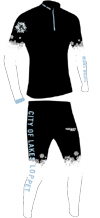 This one looks like some kind of outfit you slip into before the ship goes down. Help the Coast Guard find you: 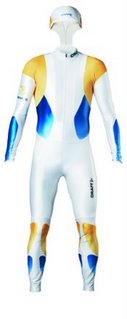 Then you got this, which is a little more subtle with the Evel Knievel thing going on:
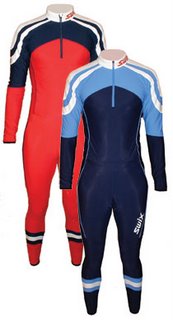 Jury's out on that. How about this?:
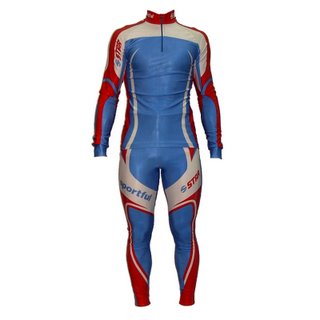 I'm thinking luge team here, I'm looking for the big helmet! Whoa! I'm kind of digging the Shark, though:
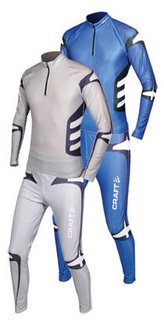 What do you think of the Shark? Those are like gills or something, that's a nice touch. I'll be honest with you. I like the ladies and the ladies like me. I don't want to blow my cred out here and look like a Fred or something if you know what I mean. Can you help a guy out? Stay cool! Stosh in Tahoe ------ My Style-Sensitive Amigo, The sad truth of the matter is that all race suits are garish. Instead of agonizing over which race suit to get you need to recognize that the crucial point here is WHEN to wear a race suit. That being said, it's far worse to not have a race suit on when in a race-suit situation than to be wearing a race suit for a casual training day. If you show up to the start of the California Gold Rush with your training pants on and a polar fleece you won't be walking away from that race with any phone numbers. (Or at least not mine!) Then again, the coolness factor of spandex is inversely proportional to your distance from the ski trails so the usefulness of a race suit compared to the price (I think these babies run $100+) is depressingly small. I mean, sure you could probably get some coffee (hot chocolate for me) at the little cafe at the trail head, but stopping at the grocery store in your matching racing spandex is not gonna fly no matter how fast you can ski. Speaking of skiing fast, don't think you have to be able to ski fast to wear a race suit. As long as you're racing as hard as you can treat yourself like a pro: wear the sweet suit, match your hat, jump up and down and swing your arms around before the start, bury your ski bases in flouro powders regardless of the actual snow conditions. Do not, however, wear a white racing suit unless you're real fast, like on-the-swedish-national-team fast. Of the suits you chose to bash I do think the Sportful and the Craft Shark suit are the least offensive. LAV p.s. Ask LAV posts only exist when LAV gets questions. LAV would be particularly pleased to field math questions lately... need help on your linear algebra homework? Labels: Ask LAV
Monday, August 20, 2007
Ask LAV
Laura: Now that you are up in the cold, cold north, you probably don't sweat that much (hah!!), but I thought I would ask you this anyway (after a 10k at lunch today in the hot sun). Do you ever have a problem, with sweat rolling down and into your eyes?? It burns like heck!!! Know of any good ideas to combat this problem? Cheers, -Scott. ---- Scott, I must say, the simple solutions are the best: run faster. If there is no head wind, you've got to create one! The sweat evaporates faster, cools you better and no stinging eyes. Of course going faster isn't always an option, especially in the longer races and training sessions. Furthermore, if you're in a humid climate the evaporation process slows dramatically. In the absence of acceleration you can either get a sweatband or glory in the agony. If you get a sweatband the most important thing to remember is that any kind of head covering and especially sweatbands MUST be worn for fashion NOT function. If you wear a sweat-mopping-up-device (and you can go with a stretchy cloth one or a bandanna or even a baseball cap works) you must wear it as an accessory to the "look" you want to create-- the stinging-eye-prevention-mechanism should only be an additional bonus to its raging stylishness. Otherwise sweatbands are gross. If you decide to glory in the agony, make the most of it. Use the experience to compose epic race stories. Preferably without using punctuation, i.e. "the sweat was just dripping into my eyes and my vision started to go blurry which wasn't really a problem because I knew the trail so well but then a moose sauntered out of the brush and because of the sweat I didn't see it until I just about hit it so I had to bust out my diving somersault between it's legs and then..." LAV Labels: Ask LAV
Wednesday, August 15, 2007
Ask LAV
Dear Lav, So I have this theory about skiing. It seems to me that skiing is a lot like drumming in that you have to coordinate several different body parts to make it work. And those coordinated parts need to work together dependently and independently. Like, for example, poling and skiing (separate but coordinated) that must adapt independently to changing terrain or snow condition and subsequent changes in technique, i.e. speed, timing etc. As evidenced by isolating skills during practice. Each movement needs it's own identity and role in order to create a satisfying whole. Just like drumming. The second part of my theory is that drummers make excellent mathematicians. And vice versa. After all isn't math, at it's core, patterns and rhythms that as a discipline is especially sensitive to discord? Drumming and skiing are differential equations - for your body! As a mathematician yourself, LAV, perhaps you've notice the connection? I guess my point is, I almost certain that when the Beatles went out for dinner, they handed the check over to Ringo to figure out the tip. What do you think? Big Fan, Mathlete from Middlebury --- Dear Mathlete, I must say, the first part of your theory with regards to skiing completely befuddled me so I'll leave that to internal musings. Let's move on to the relationship between drummers and mathematicians. Nevermind, that's beyond me too. I will say, however, that I've been musing over your question since you sent it to me (awhile ago, for my other readers' information). I almost skied off the edge of Eagle Glacier last week because I was so distracted pondering famous drum solos, unwinding the Black-Scholes differential equation, and trying to figure out how to ski. After a solid period of rumination I'm ready to present the most significant corollary to your theorem. Corollary: since (good mathematician)<=>(good drummer) and (good drummer)<=>(good skier) therefore, (good mathematician)<=>(good skier). furthermore, since (LAV)=>(good mathematician) then (LAV)=>(good skier)! there's hope! Thanks for the uplifting syllogism! LAV --- p.s. LAV is accepting any questions that you may have on skiing or life! (email her: laura@lauravalaas.com) Labels: Ask LAV
Sunday, July 29, 2007
Ask LAV
Do you monitor your morning heart rate? If so, at what point do you modify your training because your heart rate is too high? For example, I usually have a heart rate of about 35-38 when I'm fully rested but sometimes it skyrockets to 45-47 after a bounding or interval session? In short, your training plan, no matter how well planned out, is at the mercy of how your body adapts to the stress loads you place on it. If you go over those stress loads without adequate recovery you break your body down instead of up and your body suffers. Do you rely on your morning heart rate or how you feel to determine if you're ready for another hard training session?
Matthew Rowe
St. Scholastica Skier (Duluth, MN) --- Matthew- You're already a big step ahead of most skiers because you know your morning heart rate baseline. Furthermore, you clearly have a good concept of training theory and the stress & recovery cycle. I imagine there's a lot of people who are more like me: I start to feel kind of off and take my morning heart rate to see if it's elevated. Except I don't know what's elevated and what's not so it's not very informative. I discussed your question with Troy Flanagan, USSA Director of Sport Science, and Justin Carlstrom, USSA Physiologist (two wickedly smart dudes). An elevated heart rate is a sign of too much stress and not enough recovery. Justin advised not necessarily jumping to the conclusion that if your AM HR is elevated it means that you need to back down the training a notch. Often an equally effective reaction would be to increase the quantity/quality of your recovery time which would allow you to maintain a good training load. (Of course this brings up the issue of priorities when you have to decide whether an hour nap in the afternoon or going to bed early is a better use of your time than, say, going to work, watching youtube videos, finishing that paper for Psych101, or practicing your keg stands.) Troy said that you can usually get away with one day of an elevated AM HR but once you had two consecutive days of ~10bpm above normal there was (according to one of his studies with women's soccer) about an 80% chance that you would get sick about two days later. So if you think you know why your heart rate is elevated, in your case maybe because of hard intervals the day before and then spending the rest of the day in class instead of sitting on your couch, you can probably continue with your scheduled training plan. If it stays +5bpm two days in a row, you should consider cutting back on your training slightly or going out of your way to get better rest for a couple of days. If it's +10bpm two days in a row, it's time to bust out the zinc lozenges and zicam and get a head start on the upcoming soar throat and sniffles. LAV Labels: Ask LAV
| 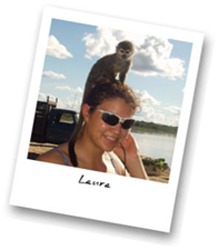 Blog Archive Recipes 
Donate! |






